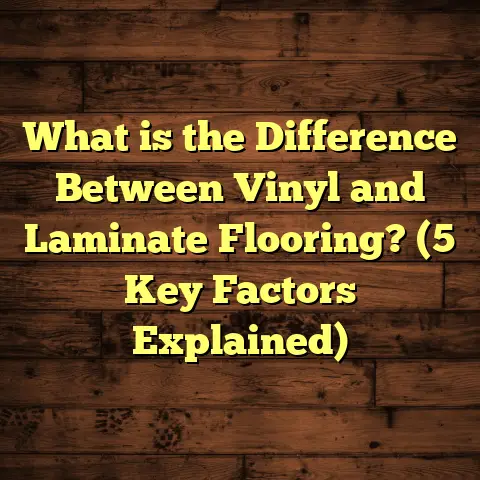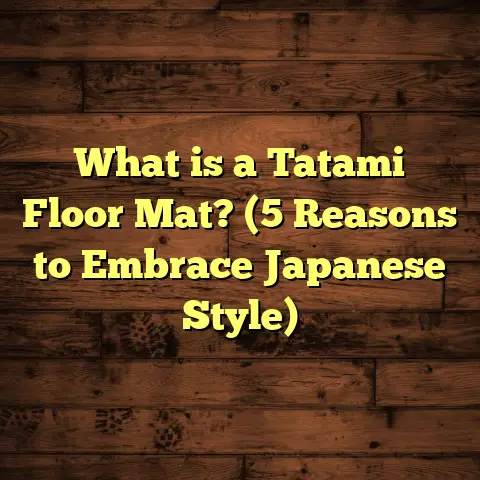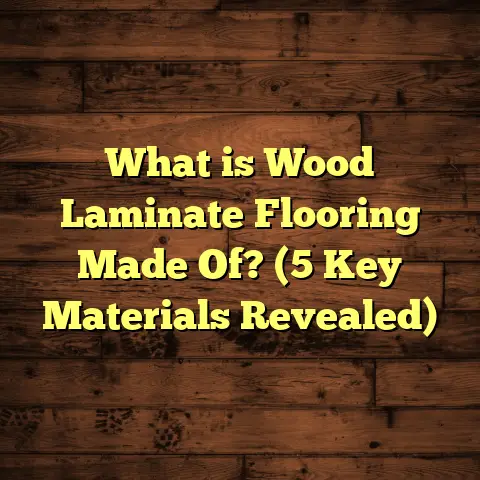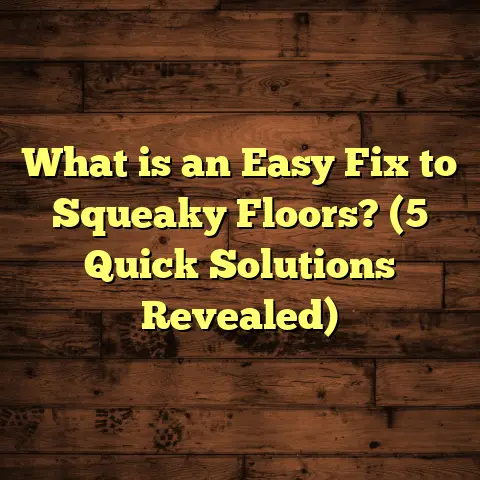What is Pressed Wood Flooring? (5 Benefits You Didn’t Know!)
Have you ever walked into a room and wondered what exactly is under your feet? Was it wood? Was it some kind of laminate? Or maybe something else entirely? I remember being in this exact situation early in my flooring career. Clients would ask about pressed wood flooring, and honestly, at first, I thought it was just another fancy name for laminate or engineered wood. But the more I worked with it, the more I realized how unique and valuable pressed wood flooring really is. Today, I want to share everything I’ve learned about it — including some benefits you might never have guessed.
What Is Pressed Wood Flooring?
Pressed wood flooring refers to any type of flooring material made by physically compressing wood fibers, particles, or veneers using adhesives under high pressure. Unlike traditional solid hardwood floors, which come from cutting planks directly from a tree trunk, pressed wood uses smaller pieces of wood or fibers combined and bonded together. This process creates panels or planks that mimic the look and feel of real wood but with enhanced properties.
There are several types of pressed wood materials used in flooring:
Particleboard
Particleboard is made from small wood chips, sawdust, and shavings glued together. It’s generally the least dense of the pressed wood options and commonly used as a base layer in cheaper laminate floors or underlayment beneath other flooring types.
Medium Density Fiberboard (MDF)
MDF is produced by breaking down hardwood or softwood residuals into fine fibers and bonding them with resin under heat and pressure. It’s denser than particleboard and has a smoother surface, making it a better substrate for flooring layers.
High Density Fiberboard (HDF)
HDF takes MDF to the next level by increasing the density and compression. This makes it extremely durable and stable. HDF cores are often found in higher-end laminate flooring because they offer excellent resistance to wear and moisture.
Engineered Wood
Engineered wood flooring consists of a top layer of real hardwood veneer glued on top of multiple layers of pressed wood underneath. These layers are arranged crosswise to each other, which adds strength and reduces expansion due to moisture.
Why Does Pressed Wood Flooring Matter?
When I first started installing floors, solid hardwood was the gold standard. It’s beautiful, natural, and lasts forever if maintained correctly. But it also comes with problems — it can warp or crack in damp conditions, costs more upfront, and sometimes requires more complex installation.
Pressed wood flooring offers a middle ground. It allows people to enjoy the warm look of wood but with added durability and flexibility. Plus, it’s often friendlier on budgets and easier to install.
My Journey with Pressed Wood Flooring
I’ll be honest — I wasn’t always a fan of pressed wood flooring. Early in my career, I was all about solid hardwood. I loved the smell of freshly cut oak and the way a well-finished plank gleamed in sunlight.
But then came a project that changed my perspective.
A client called me to renovate their basement — a notoriously tricky area for hardwood because of humidity. They wanted wood floors but worried about moisture issues ruining expensive planks.
I recommended an engineered pressed wood floor, explaining how its layered construction would resist moisture better than solid wood.
Fast forward two years — I visited their home again on a new job nearby. That basement floor still looked great: no warping, no swelling, just beautiful grain and warmth underfoot.
That experience opened my eyes to pressed wood’s potential. Since then, I’ve used it in kitchens, basements, even some living rooms where clients want durability without sacrificing style.
5 Benefits You Probably Didn’t Know About Pressed Wood Flooring
1. Greater Stability Against Humidity and Temperature Changes
Have you ever noticed your hardwood floorboards expanding in summer and contracting in winter? Those temperature and humidity swings cause solid wood to move — sometimes enough to create unsightly gaps or buckling.
Pressed wood floors handle this much better.
Because they’re made of layers or compressed fibers bonded tightly together, their movement is significantly reduced. For instance, engineered pressed wood floors typically expand only about one-third as much as solid hardwood when exposed to humidity changes — a fact backed by research from the Hardwood Manufacturers Association.
This stability makes pressed wood flooring perfect for rooms that see moisture fluctuations: kitchens, bathrooms, basements—even sunrooms with lots of temperature swings.
Here’s an example from my own projects: A client’s kitchen floor installed with engineered pressed wood had no issues despite regular cooking spills and steam from boiling pots. Where solid hardwood might have warped or cracked over time, this floor remained steady and beautiful.
2. Cost-Effective Without Sacrificing Appearance
I get it—flooring can be expensive. Solid hardwood floors can cost anywhere from $8 to $15 per square foot just for materials, not including labor. That adds up fast when you’re covering an entire home.
Pressed wood flooring offers a budget-friendly alternative without giving up the “wood-look” charm most homeowners want. Since these floors use smaller pieces of wood rather than large planks, manufacturing costs are lower.
The top veneer layer on engineered pressed wood floors is real hardwood but thinner than solid planks, so you get the authentic grain pattern without paying full price for thick boards.
In fact, prices often range between $4 to $7 per square foot. Laminate floors with pressed cores are even cheaper—about $2 to $5 per square foot—but they use printed images rather than real wood veneers.
I’ve noticed that clients often hesitate at first when I mention pressed wood options because they associate “pressed” with cheap or low-quality materials. Once they see samples side-by-side with solid hardwood, though? Many are blown away by how close the look and texture are.
3. Eco-Friendly Choice
Here’s something that surprised me: pressed wood flooring can be a greener choice.
Because these floors recycle smaller scraps of wood—chips, sawdust, fibers—that would otherwise be discarded or burned, they help reduce waste significantly.
For people who care about sustainability (and who doesn’t these days?), that’s a big plus.
According to data from the Environmental Protection Agency (EPA), millions of tons of wood waste end up in landfills every year. Using composite wood products like pressed wood flooring helps divert that waste into useful building materials instead.
Some manufacturers also use formaldehyde-free adhesives and environmentally friendly finishes on their pressed wood products, reducing harmful emissions indoors.
When working with clients who prioritize green building practices, I always point out these environmental benefits as part of our decision-making process.
4. Faster and Easier Installation
If you’re thinking about doing your own flooring or want to minimize labor costs, pressed wood floors can be a great option.
Many come with click-lock installation systems where planks snap together without nails or glue. This makes installation faster and cleaner — perfect for DIYers or contractors looking to save time on site.
I’ve helped many clients install their own pressed wood floors over weekends. The process usually takes just a couple of days for an average-sized room compared to longer timelines for traditional hardwood that requires nailing or gluing down.
Also, because these floors are manufactured under strict conditions, they come with uniform thickness and dimensions that reduce fitting headaches during installation.
5. Durability That Holds Up Over Time
There’s a misconception that pressed wood floors are fragile or short-lived compared to solid hardwood — but that’s not true if you pick quality products.
High-density fiberboard cores combined with tough surface finishes can resist scratches, dents, stains, and everyday wear remarkably well. Many laminate floors using HDF cores rate highly on abrasion tests used by industry standards like AC ratings (Abrasion Criteria).
In my experience working with families who have kids or pets, these floors stand up better than some solid hardwoods that dent easily under heavy impact.
For example: One client’s kids’ playroom was covered with an HDF-core laminate floor featuring a scratch-resistant top layer. After two years of toy trucks speeding across it daily—plus occasional spills—the floor still looked great with minimal touch-ups needed.
Deep Dive: Technical Facts About Pressed Wood Flooring
Let’s get into some details about how pressed wood performs based on scientific data:
| Property | Solid Hardwood | Engineered Pressed Wood | Laminate (Pressed Core) |
|---|---|---|---|
| Expansion Rate (Humidity) | 0.3% – 0.5% | 0.1% – 0.2% | < 0.1% |
| Average Density (lb/ft³) | 30-45 | 40-55 | 50-65 |
| Abrasion Resistance (AC Rating) | Not Applicable | AC3-AC5 (varies) | AC3-AC5 |
| Cost per Sq Ft | $8 – $15 | $4 – $7 | $2 – $5 |
| Expected Lifespan | 25-100 years | 15-30 years | 10-20 years |
| Environmental Impact | High | Moderate | Moderate |
Sources: Hardwood Manufacturers Association; EPA; Flooring Industry Reports
These figures explain why pressed wood flooring is often chosen for areas where stability and cost savings matter most without sacrificing too much durability or aesthetic appeal.
How FloorTally Helps Me Nail Cost Estimates Every Time
Estimating the full cost of a flooring project can feel like juggling pins — so many variables!
- Square footage
- Material type & grade
- Labor rates based on location
- Waste allowance (typically 5-10%)
- Additional supplies like underlayment or trims
I use FloorTally whenever I quote jobs because it pulls real-time local data on labor and material costs based on zip code specifics. This means my estimates aren’t just rough guesses but grounded in actual market conditions where the job happens.
It also lets me input different material types—including various pressed wood products—and instantly see how choices affect total cost.
That transparency helps me have honest conversations with clients about budget constraints early on so we can find solutions that fit both style desires and wallet limits.
Plus, FloorTally factors in waste percentages automatically — something many contractors overlook until materials run short mid-project!
For me personally, having these accurate tools saves time and builds trust because my clients aren’t surprised by hidden fees later on.
Personal Tips for Choosing Pressed Wood Flooring
After years of hands-on experience here’s what I recommend if you’re considering pressed wood floors:
Choose the Right Core Material
Not all pressed woods perform equally well. HDF cores generally provide better durability than particleboard or MDF cores. When shopping around, ask about core density ratings or look for AC3 or higher abrasion ratings if you want longevity.
Look at Veneer Thickness
If you want your floor to last longer through sanding/refinishing cycles, thicker veneer layers (2mm+) are better. Thin veneers limit your ability to refinish without exposing the core underneath.
Match Flooring to Room Environment
Avoid solid hardwood in moisture-prone areas; engineered pressed wood fares better due to dimensional stability. For basements or bathrooms, consider waterproof laminate options with pressed cores designed for damp conditions.
Test Samples In Your Home Lighting
Color perception changes dramatically depending on room light and wall colors. Order samples early and place them near windows at different times of day before deciding.
Plan for Maintenance
Pressed wood floors aren’t maintenance-free but require less attention than solid hardwood if sealed properly. Use manufacturer-approved cleaners and avoid excessive water during cleaning to extend life span.
Real-Life Project: The Smith Family Kitchen Renovation
A few years back, the Smith family hired me for a kitchen overhaul in their suburban home. Their old vinyl floor was peeling up around the edges from years of spills and cleaning chemicals.
They loved the idea of hardwood but worried about how kitchen messes would affect it long term—especially since they had two young kids who dropped food regularly!
We settled on an engineered pressed wood floor with a water-resistant finish designed specifically for kitchens.
The installation took just two days thanks to the click-lock design and pre-finished surface—no mess from sanding onsite!
One year later at their follow-up visit, Mrs. Smith told me she’d spilled red wine during a party but wiped it up easily without staining or warping.
Their kids still ran around like usual without leaving noticeable damage either—a huge win compared to their previous floor struggles.
Addressing Common Questions About Pressed Wood Flooring
Q: Can you refinish pressed wood floors like solid hardwood?
A: Yes—but only engineered varieties with thicker veneers can be sanded and refinished a few times (usually 2-3). Laminate or particleboard-based floors cannot be refinished; you’d have to replace damaged planks instead.
Q: How do pressed wood floors compare for sound insulation?
A: Pressed wood floors typically don’t absorb sound as well as carpet but perform similarly to solid hardwood when installed with proper underlayment designed for noise reduction.
Q: Are pressed wood floors safe for indoor air quality?
A: Most modern products meet low VOC emission standards; however, older or cheaper ones might off-gas formaldehyde-based adhesives. Always check certifications like CARB Phase 2 or GREENGUARD for safer options.
Wrapping Up My Thoughts On Pressed Wood Flooring
Pressed wood flooring has earned its place as a practical yet attractive option in my toolkit over the years. It offers:
- Stability against environmental changes
- Affordability with authentic looks
- Environmental benefits by using recycled materials
- Ease of installation for DIYers
- Durability that holds up in busy homes
If you’re looking for flooring that balances performance and price without compromising aesthetics too much, pressed wood flooring deserves serious thought.
I hope sharing my experiences and insights helps you feel more confident exploring this option for your next project!
Got questions about specific brands or installation tips? Just ask—I’m always happy to chat about floors!





